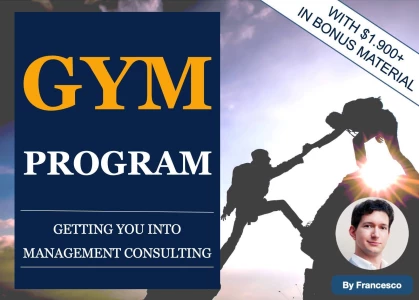Does anybody have any tips for how to practice analyzing charts and graphs for case interviews?
My difficulty is knowing what information to look for, relating it to the case prompt, and then continuing the case based on my insight.
Does anybody have any tips for how to practice analyzing charts and graphs for case interviews?
My difficulty is knowing what information to look for, relating it to the case prompt, and then continuing the case based on my insight.


Hi there,
Q: Does anybody have any tips for how to practice analyzing charts and graphs for case interviews?
The approach I would suggest is the following:
1. READ THE GRAPH
2. ANALYZE THE GRAPH AND FIND THE KEY INSIGHTS
3. PROPOSE THE NEXT STEPS
Best,
Francesco

Here are some tips to help you practice and improve:
Familiarize yourself with different chart types: Understand the common types of charts and graphs you may encounter, such as bar charts, line charts, pie charts, and scatter plots. Learn how to interpret the information presented in each type of chart.
Start with the basics: When you first look at a chart or graph, take a moment to understand its title, axis labels, and legend. This will give you a clear understanding of what the chart is representing.
Identify key trends and patterns: Look for any noticeable trends, patterns, or outliers in the data. Pay attention to changes over time, variations between different categories, or any significant deviations from the norm.
Relate the information to the case prompt: Think about how the information in the chart relates to the case objective or question at hand. Consider how the insights from the chart can help you answer the case prompt or provide valuable insights to support your analysis.
Make connections and draw conclusions: Use the information from the chart to make connections and draw conclusions. Think about the implications of the data and how it may impact the overall case. Consider potential hypotheses or recommendations based on your insights.
Practice with real-world examples: Look for real-world examples of charts and graphs, such as business reports, news articles, or industry publications. Practice analyzing these examples and discussing your findings with a case partner or coach.
Remember, practice is key to improving your chart analysis skills. The more you practice, the more comfortable and confident you will become in analyzing charts and using them to drive your case analysis.

Hi there!
Yes - I'd propose a few steps
First, read the exhibit with the interviewer and ask any clarifying questions. Don't start interpreting at this point. The objective is only to get an understanding of the sort of data contained in the exhibit.
Second, take time and aim to come up on your own with 2-4 self-standing insights (bullet points / mini-paragraphs of content).
Third, get back to the interviewer and take them in a structure way through the insights. For each insight, pick a data point, explain what it means and what the client should do as a consequence of it. This last part is super important - you are expected to be prescriptive and providing a hypothesis or next steps for the client, not only descriptive of the data
Fourth, if you're at the right skill level / distinctive candidate, you can take a step back after presenting these insights and aim to connect the dots. Here your task is to ‘create the story’ for the client i.e., paint a holistic image of where they are and where they should be going.
Best,
Cristian
———————————————
Practicing for interviews? Check out my latest case based on a first-round MBB interview >>> SoyTechnologies

Hi,
I see a lot of errors during my coaching sessions. The most common one is misunderstanding of the chart because candidates try to have a global understanding in 2 sec (mostly intuitive candidates).
My advice would be the following :
1. Read slowly every titles, notes, etc. and be sure to understand what you just read.
2. See what's the direct messages you can extract from the graph (don't try to find to complicated things, the answer is in the graph!)
3. Communicate with the interviewer on what you understand to be sure you go in the right direction
4. Propose a synthesis to the interviewer
Hope this helps,
Cheers,

Best Practice Strategy/Resources
1) Practice in RocketBlocks
2) Practice in casebooks. LabCo and Enerforce are two of my favorite chart-based cases.
3) Read the Economist (especially the graphic detail)
4) Ask case partners to focus particularly on your chart-reading skills (i.e. by providing you with cases with many charts) - Bain and Deloitte cases tend to be chart heavy
5) Get a coach. For example, I run a number of exhibit/chart interpretation training programs for other academies/learning centers. Feel free to reach out to get the same training!
In terms of being able to interpret charts/graphs effectively
1) Read the title - and understand it
2) Read the legends - and understand them
3) Remind yourself of the objective / hypothesis in the case, to see where this might fit
4) Find the differences - where does the line graph plummet or spike? Which column is a lot smaller or bigger than the others? Where does change occur? The differences are what matter
5) Talk outloud while interpreting - first, it helps you think and process your thoughts, second, it lets the interviewer provide guidance and course correct if needed.

Hi there,
a critical component of interviews indeed. Ultimately your ability to describe the chart (descriptive analytics), ideate hypotheses for drivers/patterns (creative thinking), and ability to synthesize implications are tested. Here are my 3 steps to strong chart reading:
Observe (What): Begin by carefully observing the chart. Understand the key components, such as data points, axes, labels, and any trends or patterns. This is the descriptive analytics part.
Analyze (Why): Delve deeper to analyze why the data is presented in this way. Consider the context and purpose of the chart. Are there specific drivers or factors contributing to the trends? Use your creative thinking skills to ideate hypotheses about what might be causing these patterns.
Synthesize (So-What): The most critical step is to synthesize the implications of what you've observed and analyzed. What does this data mean for the business or the case at hand? How does it relate to the broader problem or solution? This is where you demonstrate your ability to derive insights and communicate their significance effectively.
Warm regards,
Frederic

Hi there,
Great question!
If you're ‘looking for information’, you're not going to be successful. That's because you have to work for the insights and have to proactively look for opportunities to do some basic arithmetic as opposed to waiting for things to pop out.
Here's an example:
It's not the only key to success but the above step is missed by many candidates and is quite foundational for good performance on exhibits.
Feel free to get in touch if you'd like to learn more. For now, I hope this helps a bit.
Best of luck!
Moritz

Hi there,
My advice to analyzing charts during interviews:
I hope this helps!
Alberto
—
Check out my latest case based on a real MBB interview: Sierra Springs













